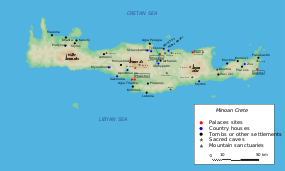 Map of Minoan Crete | |
| Location | Lasithi, Crete, Greece |
|---|---|
| Coordinates | 35°06′20″N 25°47′20″E / 35.10556°N 25.78889°E |
| Type | Minoan town and "palace" |
| History | |
| Cultures | Minoan |
| Site notes | |
| Excavation dates | 1901, 1903, 1904, 1971-1972, 1976, 1992-1994, 2010–2014 |
| Archaeologists | Harriet Boyd Hawes, Jeffrey Soles, Costis Davaras, Vance Watrous |
| Public access | Yes |
Gournia (Greek: Γουρνιά) is the site of a Minoan palace complex in the Lasithi regional unit on the island of Crete, Greece. Its modern name originated from the many stone troughs that are at the site and its original name for the site is unknown.[1] It was first permanently inhabited during the Early Minoan II periods (approximately between 2650-2100 B.C.E) and was occupied until the Late Minoan I period (approximately between 1700-1470 B.C.E.).[2] Gournia is in a 6 mile cluster of with other Minoan archeological sites which includes Pachyammos, Vasiliki, Monasteraki, Vraika and Kavusi. The site of Pseira is close but slightly outside the cluster.[3]
- ^ [1]Watrous, L. Vance, et al., "Excavations at gournia, 2010–2012", Hesperia: The Journal of the American School of Classical Studies at Athens 84.3, pp. 397-465, 2015
- ^ Buell, D. Matthew, and John C. McEnroe, "Community building/building community at Gournia", Minoan Architecture and Urbanism: New Perspectives on an Ancient Built Environment, pp. 204-227, 2017
- ^ [2]Richard Seager, "The Cemetery of Pachyammos. Crete", University museum, Anthropological publications, University of Pennsylvania, 1916